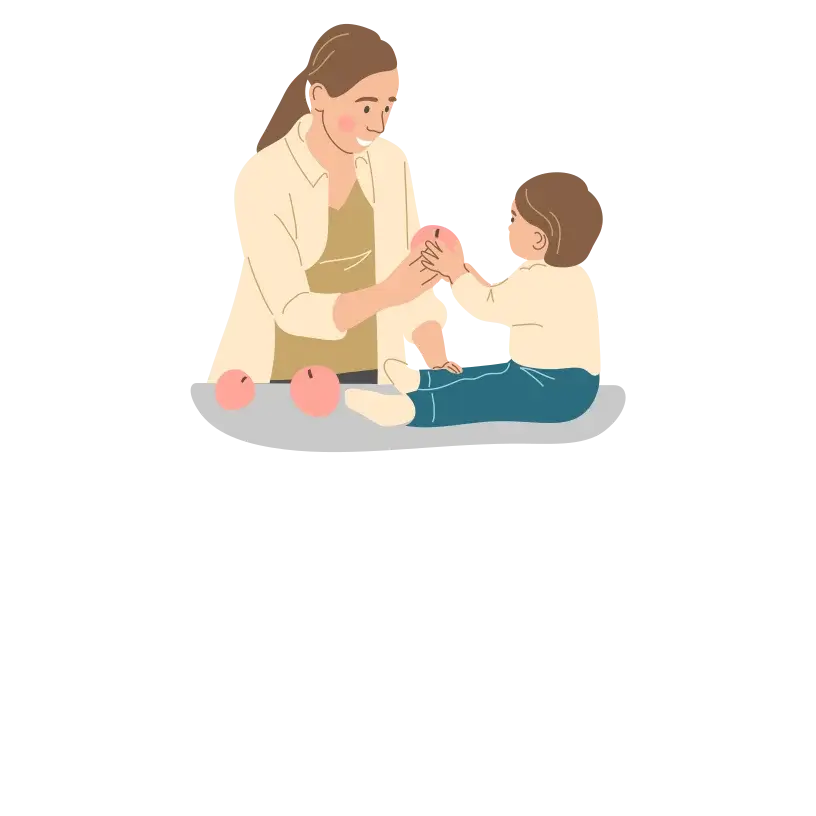Menu

As your baby turns ten months old, you’ll see more of their personality shining through each day. Sometimes, it’s amazing, and other times, it can be a bit tricky – both feelings can happen at the same time! Just remember, even if they seem grown-up sometimes, they’re not.
Your baby is in a special time of growing up, learning about the world, and dealing with strong feelings.
Now that your curious little one is moving around, they’ll find new ways to explore. It’s like a fun adventure full of interesting things to discover. Paying attention to the cool things they’re learning and doing can help you support their growth.
As your baby grows, they’re getting bigger and smarter. They can now recognize their favorite toys and understand simple instructions from you. Their playfulness shines through, and they might even give you cues, like clasping their hands together, to invite you to join in on the fun. It’s a delightful stage of development filled with their emerging understanding and playful interactions.
At ten months, there tends to be a noticeable difference in the average weight and length between male and female babies. On average, male baby boys weigh around 20.2 pounds, slightly more than female babies, who have an average weight of 18.7 pounds.
Similarly, male babies are typically around 28.9 inches long, while female babies are a bit shorter on average, measuring around 28.1 inches. These variations in size between genders are part of the normal range of development and growth during infancy.
Fever: If your infant registers a temperature of 102 F (38.9 C), it could indicate an infection such as a cold, flu, ear infection, or pneumonia. Contact your baby’s healthcare provider for guidance, and remain vigilant for additional signs of illness. Use a digital thermometer for precise temperature readings to accurately assess your baby’s health.
Diarrhea: Diarrhea can be a common concern in infants, often due to viral infections, dietary changes, or sensitivities. It’s essential to monitor for signs of dehydration, such as reduced urine output or lethargy, and seek medical advice if needed.
Irregular stool: If your baby, whether breastfed or bottle-fed, is passing very hard or dry stools, it could indicate a need for more fluids. This situation may arise due to factors like insufficient fluid intake, increased fluid loss, illness, or exposure to heat.
Once your baby begins eating solid foods, hard stools might be attributed to an early introduction of constipating foods such as cow’s milk, before their system is ready to handle them effectively. Monitoring your baby’s diet and ensuring adequate hydration is crucial for maintaining healthy bowel movements.
Food Allergies: Your baby can develop allergic reactions to certain foods like cow’s milk, eggs, peanuts, soy, and wheat. Introducing cow’s milk is generally advised after 12 months due to its potential for allergic reactions.
Allergic symptoms can vary from mild to severe, encompassing issues like rash, diarrhea, breathing difficulties, or pale skin.
If you suspect a food allergy, it’s crucial to consult with your baby’s healthcare provider for a proper diagnosis and guidance on the necessary actions. This may involve avoiding specific allergenic foods. In some cases, children outgrow their allergies over time.
Urination: Monitor your baby’s urination – they should wet at least four diapers daily. Any signs of distress during urination might indicate a urinary tract issue.
A salmon-coloured or pinkish stain on the diaper indicates concentrated urine, which is generally not a concern. However, persistent staining warrants a discussion with your baby’s doctor.
Babies between 6 and 12 months are naturally curious and increasingly mobile. During this time, they explore their surroundings by putting objects in their mouths and attempting to interact with everything. However, this curiosity comes with potential risks, as they can pull chairs, fall down the stairs, and access cabinets and drawers.
You must be vigilant and childproof your home. This involves examining each room from your baby’s perspective, identifying potential hazards, and taking steps to ensure a safe environment.
Proactive measures, such as securing furniture, installing safety gates, and keeping harmful items out of reach, significantly reduce the risk of injuries and create a secure space for your baby to explore and learn.
Around ten months, your baby might get easily distracted during breastfeeding or bottle-feeding. It can be helpful to minimize distractions while feeding. Even though your baby eat more solid foods, the nutrition of breast milk or formula remains crucial. As feeding sessions become less frequent, take the opportunity to enjoy these special one-on-one moments with your baby.
For a baby at this stage, the typical recommendations for daily intake involve approximately 24 ounces of formula spread across three to four feedings. In addition to formula, their diet should ideally include two to four servings of fruits, two to four servings of vegetables, two to three servings of protein-rich foods, and some starches.
By ten months, your baby is likely accustomed to having three meals a day – breakfast, lunch, and tea – alongside their milk feeds. During lunch and tea, you can introduce a main course and a pudding, which could be something like fruit or unsweetened yoghurt.
It’s beneficial to share mealtimes whenever you can, as babies learn by observing. Eating together provides a valuable opportunity for your baby to observe your eating habits, fostering a positive environment around meals and encouraging healthy eating habits.
By now, your baby should be gaining confidence in using their cup and taking sips of water independently. It’s crucial to be mindful of beverage choices, as sweet drinks such as squash, fizzy drinks, milkshakes, and fruit juice can contain high sugar levels, potentially contributing to tooth decay. Even baby and toddler drinks may have added sugars, so avoiding these is advisable to promote oral health.
Encouraging water consumption and steering clear of sugary beverages contribute to your baby’s overall well-being.
Around six months, your baby is mastering the “pincer grasp,” a key development allowing them to pick up smaller food pieces with two fingers. This indicates their readiness for finger foods, offering an opportunity for self-feeding. Here are some soft and safe options for your baby to explore:
By ten months, your baby will likely show interest in your meals and want to taste what you’re eating. As they are ready for most table foods at this stage, incorporating a variety of nutritious options onto your plate becomes important. This might prompt you to be mindful of your food choices.
Consider including veggies on your plate to set a positive example and introduce healthy options to your little one’s growing palate.
According to the American Academy of Sleep Medicine, babies under one year old should aim for 12 to 16 hours of sleep in 24 hours. Even as your little one approaches their first birthday, they require substantial sleep.
At 10 months, your baby might transition to 2 naps daily and potentially sleep through the night. Their awake periods extend to around 2.5 to 3.5 hours at a time. It’s important to strategically plan wake times, with shorter wake windows earlier in the day and a longer one before bedtime, promoting a consistent sleep pattern.
If you haven’t already, this age could be an opportune moment to consider sleep training, as it might contribute to better sleep habits.
Between 6 and 18 months, your baby may exhibit signs of separation anxiety, potentially causing sleep regression. They are learning to recognize your absence, leading to nighttime waking and crying.
If your baby wakes up crying at night during this phase, allow a few minutes for them to self-soothe. If the crying persists, try calming them with a gentle pat or soft words to help them settle back to sleep. It’s advisable to resist picking them up, walking around, or bringing them to your bed.
Encourage self-soothing behaviours, but avoid introducing comfort objects such as a favourite blanket or plush toy until they’re at least one year old. Experts caution against placing stuffed animals or blankets in the crib during the first year to reduce the risk of SIDS (Sudden Infant Death Syndrome).

Your 10-month-old’s sight has progressed significantly. Initially, they could only see objects briefly, but now their vision is sharp and clear. They can perceive objects across large rooms, recognize familiar faces, distinguish colors, shapes, and patterns, and even spot their favorite toys from afar.

At ten months old, your baby’s hearing has significantly improved. They can now distinguish and recognize familiar sounds, including your voice, your partner’s voice, and other household sounds like a ringing phone, doorbell, or the noises made by a family pet. This heightened sense of hearing reflects their growing awareness of the auditory world.

At ten months, your curious baby is eager to explore everything in sight, emphasizing the need to babyproof your home and ensure hazardous items are out of reach.
Once the environment is secure, embrace and encourage their curiosity. Regarding touch, if you haven’t started baby massages yet, it’s never too late! Massaging your baby not only strengthens the bond between you two but also promotes relaxation, aids in development, and contributes to better sleep.

As your child explores new foods and flavors, their sense of taste rapidly develop. Pay attention to their preferences by introducing various foods and noting which ones they enjoy most.
Your baby possesses a keen sense of smell, yet they are becoming acquainted with new scents and organizing them mentally. Their developing sense of smell contributes to their understanding and recognition of different odors as they encounter various smells.

Your 10-month-old’s sight has progressed significantly. Initially, they could only see objects briefly, but now their vision is sharp and clear. They can perceive objects across large rooms, recognize familiar faces, distinguish colors, shapes, and patterns, and even spot their favorite toys from afar.

At ten months old, your baby’s hearing has significantly improved. They can now distinguish and recognize familiar sounds, including your voice, your partner’s voice, and other household sounds like a ringing phone, doorbell, or the noises made by a family pet. This heightened sense of hearing reflects their growing awareness of the auditory world.

At ten months, your curious baby is eager to explore everything in sight, emphasizing the need to babyproof your home and ensure hazardous items are out of reach.
Once the environment is secure, embrace and encourage their curiosity. Regarding touch, if you haven’t started baby massages yet, it’s never too late! Massaging your baby not only strengthens the bond between you two but also promotes relaxation, aids in development, and contributes to better sleep.

As your child explores new foods and flavors, their sense of taste rapidly develop. Pay attention to their preferences by introducing various foods and noting which ones they enjoy most.
Your baby possesses a keen sense of smell, yet they are becoming acquainted with new scents and organizing them mentally. Their developing sense of smell contributes to their understanding and recognition of different odors as they encounter various smells.
Irritability: Look for increased fussiness, expressed through crying, restlessness, or general fussiness without an apparent cause. Pay attention to the frequency and intensity of these behaviors.
Changes In Sleep Patterns: Discomfort can affect sleep, leading to difficulty settling down for naps, disruptions in nighttime sleep, or an increase in nighttime awakenings. Note any alterations in sleep routines.
Refusal of Food: Changes in appetite, including a lack of interest in eating or refusal of usual feeds, may indicate underlying discomfort. Observe patterns or consistency in their feeding behaviors.
Frequent Crying: Persistent, inconsolable crying episodes can strongly indicate discomfort. Evaluate the duration and circumstances surrounding these bouts of crying.
Increased Clinginess: Discomfort may make your baby seek more comfort from you. Notice if they become unusually clingy, seeking more physical closeness than usual.
Changes In Bowel Movements: Your baby’s digestive system matures at six months, and you may notice changes in their bowel movements. Discomfort or other factors can lead to variations such as constipation, diarrhea, or irregularities in their usual patterns.
Rubbing Eyes Or Ears: Your baby may display signs of discomfort, such as rubbing their eyes or tugging at their ears. These actions could indicate discomfort related to teething or ear issues. It’s essential to observe if these behaviors align with other signs of discomfort, ensuring you promptly address your baby’s needs and provide comfort and care.
Unusual Body Movements: Watch for discomfort cues in your baby’s body language, such as squirming, arching their back, or other unusual movements. These movements may provide insights into their discomfort or pain.

Your baby is entering a stage where they’re eager to explore the world on their feet, taking those first steps while finding comfort in holding your hands for support. It’s a beautiful blend of growing independence and a desire for connection.

A little scientist in the making! Your baby is embracing their natural curiosity, engaging with objects to unravel the mysteries of how things work. This hands-on exploration is a crucial part of their cognitive development.

Language comprehension is blossoming. Your baby can now grasp the meaning of simple words and requests, indicating a developing communication skill that lays the foundation for future language acquisition.

Social interactions are becoming more expressive. Your baby waving goodbye is a delightful sign of their emerging ability to communicate and participate in social gestures, a small yet significant step in their social development.

Recognition and responsiveness are taking center stage. Your baby turning to their name being called reflects an evolving awareness of their identity and its associated sounds, strengthening the parent-child connection.

Independence in action! Your baby is transitioning to drinking from a cup held for them, showcasing newfound motor skills and a sense of self-sufficiency in daily routines.

The first steps of a remarkable journey. Your baby might be on the verge of those initial independent steps, signifying a major physical milestone and the beginning of a more mobile phase.

Standing tall and proud! Your baby’s ability to stand without support demonstrates increased strength and balance, marking a significant achievement in their physical development.

The budding food critic emerges. Your baby is forming distinct preferences for tastes and textures, showcasing a developing palate and an individualized approach to the culinary world. It’s a delightful exploration of their unique likes and dislikes.
At 10 months, your baby becomes more mobile and expressive, exploring their world rapidly. Every child develops differently, so it’s okay if they don’t reach every milestone simultaneously. They’re likely progressing just fine as long as they’re active and engaged!

Your baby is entering a stage where they’re eager to explore the world on their feet, taking those first steps while finding comfort in holding your hands for support. It’s a beautiful blend of growing independence and a desire for connection.

A little scientist in the making! Your baby is embracing their natural curiosity, engaging with objects to unravel the mysteries of how things work. This hands-on exploration is a crucial part of their cognitive development.

Language comprehension is blossoming. Your baby can now grasp the meaning of simple words and requests, indicating a developing communication skill that lays the foundation for future language acquisition.

Social interactions are becoming more expressive. Your baby waving goodbye is a delightful sign of their emerging ability to communicate and participate in social gestures, a small yet significant step in their social development.

Recognition and responsiveness are taking center stage. Your baby turning to their name being called reflects an evolving awareness of their identity and its associated sounds, strengthening the parent-child connection.

Independence in action! Your baby is transitioning to drinking from a cup held for them, showcasing newfound motor skills and a sense of self-sufficiency in daily routines.

The first steps of a remarkable journey. Your baby might be on the verge of those initial independent steps, signifying a major physical milestone and the beginning of a more mobile phase.

Standing tall and proud! Your baby’s ability to stand without support demonstrates increased strength and balance, marking a significant achievement in their physical development.

The budding food critic emerges. Your baby is forming distinct preferences for tastes and textures, showcasing a developing palate and an individualized approach to the culinary world. It’s a delightful exploration of their unique likes and dislikes.
At 10 months, your baby becomes more mobile and expressive, exploring their world rapidly. Every child develops differently, so it’s okay if they don’t reach every milestone simultaneously. They’re likely progressing just fine as long as they’re active and engaged!
Establishing a sleep schedule for your 10-month-old is advantageous for various reasons. It creates a consistent routine, promoting better sleep quality and duration while regulating your baby’s internal body clock for improved sleep patterns.
A set bedtime and nap routine offer structure to your day, allowing for planned activities and personal time. Beyond practical benefits, a consistent sleep schedule fosters healthy sleep habits in your baby, contributing to their overall well-being and supporting physical and cognitive development.
You can introduce muffins to your 10-month-old’s diet, but it’s important to ensure they are soft, cut into small, manageable pieces, and free from any potential choking hazards. Additionally, consider the ingredients to avoid any allergens or excessive sugar content. Always supervise your baby while they are eating to prevent choking incidents.
By ten months, a baby typically has an average of about 4 to 6 teeth emerging. Teething varies among infants, and the number of teeth can differ. It’s common for the lower and upper central incisors to appear first, followed by the lateral incisors. Teething patterns can vary, so, some babies may have more or fewer teeth at this stage.
Even though it’s common for babies to consume less formula as they are introduced to solid foods, it’s important to continue providing formula until your baby reaches at least one year old. At this age, babies still require the essential nutrients found in formula. Avoid introducing cow’s milk before their first birthday, as they may struggle to digest it, which could lead to the risk of iron deficiency anaemia.
While it’s normal for a 10-month-old to miss one or two developmental milestones, if they cannot stand unsupported, does not learn to use gestures such as shaking of the head or do not sit steadily, or if they have regressed in skills, it’s advisable to consult your healthcare providers.
Additionally, if your baby is not making or mimicking sounds and isn’t engaging in interactive games, it’s a reason to reach out to your pediatrician.
Establishing a sleep schedule for your 10-month-old is advantageous for various reasons. It creates a consistent routine, promoting better sleep quality and duration while regulating your baby’s internal body clock for improved sleep patterns.
A set bedtime and nap routine offer structure to your day, allowing for planned activities and personal time. Beyond practical benefits, a consistent sleep schedule fosters healthy sleep habits in your baby, contributing to their overall well-being and supporting physical and cognitive development.
You can introduce muffins to your 10-month-old’s diet, but it’s important to ensure they are soft, cut into small, manageable pieces, and free from any potential choking hazards. Additionally, consider the ingredients to avoid any allergens or excessive sugar content. Always supervise your baby while they are eating to prevent choking incidents.
By ten months, a baby typically has an average of about 4 to 6 teeth emerging. Teething varies among infants, and the number of teeth can differ. It’s common for the lower and upper central incisors to appear first, followed by the lateral incisors. Teething patterns can vary, so, some babies may have more or fewer teeth at this stage.
Even though it’s common for babies to consume less formula as they are introduced to solid foods, it’s important to continue providing formula until your baby reaches at least one year old. At this age, babies still require the essential nutrients found in formula. Avoid introducing cow’s milk before their first birthday, as they may struggle to digest it, which could lead to the risk of iron deficiency anaemia.
While it’s normal for a 10-month-old to miss one or two developmental milestones, if they cannot stand unsupported, does not learn to use gestures such as shaking of the head or do not sit steadily, or if they have regressed in skills, it’s advisable to consult your healthcare providers.
Additionally, if your baby is not making or mimicking sounds and isn’t engaging in interactive games, it’s a reason to reach out to your pediatrician.
1. American Academy of Pediatrics: Why do infants need formula instead of cow’s milk?
2. Center for Disease Control and Prevention: Clinical Growth Charts:
3. First things first: Baby Safety (6-12 Months)
4. Nationwide Children: Babies’ warning signs:
5. Nationwide Children’s’: Dental: Teeth and Gum Care for Infants and Toddlers
6.NHS: 10:12 Months Feeding
7. Stanford Children’s Health: Feeding guide for the first year
8. Washington University: Developmental milestones table
9. The children’s League: Developmental Red Flags
© Mindsmaking 2024